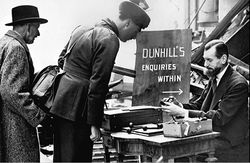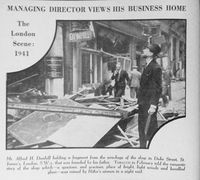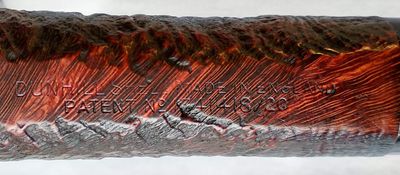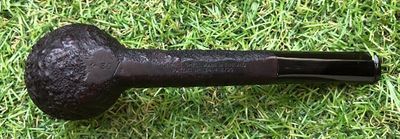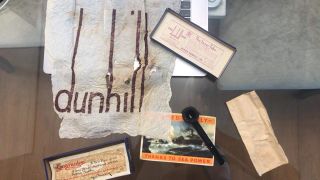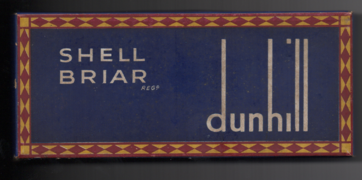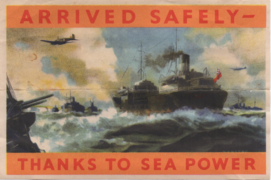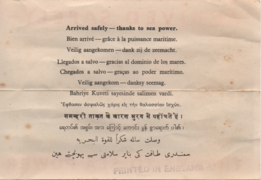WWII Phase
In mid-1941, during the the infamous Luftwaffe Blitz bombing of London, the Alfred Dunhill store (and many others in the surrounding area) were bombed and almost totally destroyed. The restoration was not fully completed until 1953. A popular piece of lore from that period is that Dunhill employees called Sir. Winston Churchill at 4:00 a.m. to ensure him that his private collection of cigars housed in the store's humidifier had been transferred safely out of danger. As we will see in the following image, Henry Dunhill continued to sell pipes amongst the rubble and ruins of his shop. An example of his remarkable resiliency.
Alfred Henry Dunhill began his journey ahead of the brand after his father's appointment in 1928, becoming the president. A function He exercised until 1961, when he decided to leave the scene and transfer possession of the post to his sister, Mary Dunhill. He passed away ten years later, in 1971, at the age of 75.
In another rare image, courtesy of our friend Jonathan Guss, we have a clipping of a magazine that says:
Mr. Alfred H. Dunhill holding a fragment from the wreckage of the shop in Duke Street, St. Jame's in London, that was founded by his father. Tobbaco in February told the romantic story of the shop which a spacious, and gracious, place of bright and bright, light woods and bevelled glass, was ruined by Hitler's airmen in a night raid.
The Second World War was a difficult time. The rationing that the war promoted was so draconian that Dunhill suffered from the scarcity of raw material until the beginning of the 50 years in the post-war period.
Dunhill published catalogues annually, even during the First World War and was each more elegant than the other. However, from 1940 to 1950 there was cessation, with no catalogs during this period. Saved only by two catalogs of "gifts", distributed in North America around 1943 and at the end of the 1940, in Great Britain.
According to John Loring, few pipes (and mostly uninteresting) were produced by Dunhill during the 40 decade. The Italian Briar for smooth pipes was extremely scarce, while the situation for the Algerian Briar (used in the sandblasted) was just a little better. Likewise, the vulcanite for the stems was a rationed or forbidden material, so that many, if not most of the pipes produced during the war, were equipped with horns stems (the horn is a very comfortable material, however, fissure With a certain ease).
Still according to Loring, the pipes of this period that are found nowadays and that are equipped with vulcanite stems, probably had the stem replaced. It would not be surprising if after the war Dunhill had – routinely – replaced the horn stems with the vulcanite, with little or no cost.
Loring defends a hypothesis in his article called A Hypothetical WWII Pipe, in which he considers that during this period the following nomenclature was used:
No date code or any other nomeclature, like the inner tube, for example. According to the available historiography, the 1341418/20 patent begins to appear in 1920, almost always followed by another patent, as an example: PATENT MARCH.9.15 1341418/20. In rare cases he appeared alone. We recently had access to a pipe bought at that period (unsmoked!), perfectly aligned with the Loring's hypothesis. Take special attention to the flyer (that reminds us of the war) that say: Arrived Safely - Thanks to Sea Power
and that reminds us of the war.
- WWII Pipe - Shell, Liverpool
Until mid-1936 – approximately – The nomenclature was done with the possessive, i.e. "Dunhill's Shell". After this period the possessive was removed, becoming "Dunhill Shell". Thus, as the pieces in question are already from the time of possessive suppression, we only have to assume that they are later than 1936. Only pieces were found with this patent until the beginning of the 30s (1933 specifically), returning to appear in the beginning of the decade of 40 (up to 45, perhaps), when it was replaced by 417574/34. Some pieces have the same patent in the beginning of the decade of 40 (1941/42), however, with the suffix "U.S.", namely: U.S. PATENT 1341418/20, being destined for the North American market.
